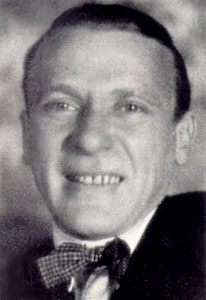Mikhail Bulgakov (Mikhail Bulgakov)

After illness Mikhail Bulgakov abandoned his career as a doctor for that of a writer. In his autobiography, he recalled how he started writing: “Once in 1919 when I was traveling at night by train I wrote a short story. In the town where the train stopped, I took the story to the publisher of the newspaper who published the story”. Though his first fiction efforts were made in Kiev, he only decided to leave medicine to pursue his love of literature in 1919. His first book was an almanac of feuilletons called Future Perspectives, written and published the same year. In December 1919 Bulgakov moved to Vladikavkaz. He wrote and saw his first two plays, Self Defence and The Turbin Brothers, being produced for the city theater stage with great success. After travelling through the Caucasus, Bulgakov headed for Moscow, intending “to remain here forever”. It was difficult to find work in the capital, but he was appointed secretary to the literary section of Glavpolitprosvet (Central Committee of the Republic for Political Education). In September 1921 Bulgakov and his wife settled near Patriarch’s Ponds, close to Mayakovskaya metro station on Bolshaya Sadovaya street, 10. To make a living, he started working as a correspondent and feuilletons writer for the newspapers Gudok, Krasnaia Panorama and Nakanune, based in Berlin. For the almanac Nedra, he wrote Diaboliad, The Fatal Eggs (1924), and Heart of a Dog (1925), works that combined bitter satire and elements of science fiction and were concerned with the fate of a scientist and the misuse of his discovery. The most significant features of Bulgakov’s satire, such as a skillful blending of fantastic and realistic elements, grotesque situations, and a concern with important ethical issues, had already taken shape; these features were developed further in his most famous novel.
Between 1922 and 1926 Mikhail Bulgakov wrote several plays (including Zoyka’s Apartment), none of which were allowed production at the time. The Run, treating the horrors of a fratricidal war, was personally banned by Joseph Stalin after the Glavrepertkom (Department of Repertoire) decided that it “glorified emigration and White generals”. In 1925 Bulgakov divorced his first wife and married Lyubov Belozerskaya. When one of Moscow’s theatre directors severely criticised Bulgakov, Stalin personally protected him, saying that a writer of Bulgakov’s quality was above “party words” like “left” and “right”. Stalin found work for the playwright at a small Moscow theatre, and next the Moscow Art Theatre (MAT). On October 5, 1926, Days of the Turbins, the play which continued the theme of The White Guard (the fate of Russian intellectuals and officers of the Tsarist Army caught up in revolution and Civil war) was premièred at the MAT Stalin liked it very much and reportedly saw it at least 15 times. Ivan Vasilievich, Last Days (Pushkin), and Don Quixote were banned. The premier of another, Moliere (The Cabal of Hypocrites), in which Bulgakov plunged “into fairy Paris of the XVII century”, received bad reviews in Pravda and the play was withdrawn from the theater repertoire. In 1928, Zoyka’s Apartment and The Purple Island were staged in Moscow; both comedies were accepted by public with great enthusiasm, but critics again gave them bad reviews. By March 1929 Bulgakov’s career was ruined when Government censorship prevented the publication of any of his work and staging of any of his plays.
In despair, Mikhail Bulgakov first wrote a personal letter to Joseph Stalin (July 1929), then on March 28, 1930, a letter to the Soviet government. He requested permission to emigrate if the Soviet Union could not find use for him as a writer. In his autobiography, Bulgakov claimed to have written to Stalin out of desperation and mental anguish, never intending to post the letter. He received a phone call directly from the Soviet leader, who asked the writer whether he really desired to leave the Soviet Union. Bulgakov replied that a Russian writer cannot live outside of his homeland. Stalin gave him permission to continue working at the Art Theater; on May 10, 1930, he re-joined the theater, as stage director’s assistant. Later he adapted Gogol’s Dead Souls for stage. In 1932, Bulgakov married for the third time, to Yelena Shilovskaya, who would prove to be inspiration for the character Margarita in his most famous novel, which he started working on in 1928. During the last decade of his life, Bulgakov continued to work on The Master and Margarita, wrote plays, critical works, stories, and made several translations and dramatisations of novels, librettos. Many of them were not published, other ones were “torn to pieces” by critics. Much of his work (ridiculing the Soviet system) stayed in his desk drawer for several decades. The refusal of the authorities to let him work in the theatre and his desire to see his family who were living abroad, whom he had not seen for many years, led him to seek drastic measures[clarification needed]. Despite his new work, the projects he worked on at the theatre were often prohibited, and he was strained and unhappy. Mikhail Bulgakov died from nephrosclerosis (an inherited kidney disorder) on March 10, 1940. He was buried in the Novodevichy Cemetery in Moscow. His father had died of the same disease, and from his youth Bulgakov had guessed his future mortal diagnosis.
Born
- May, 15, 1891
- Kiev, Ukraine
Died
- March, 03, 1940
- Moscow, Russia
Cause of Death
- nephrosclerosis
Cemetery
- Novodevichy Cemetery
- Moscow, Russia



